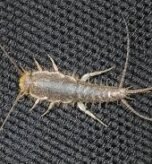Silverfish are common household pests that, while harmless to humans, can cause significant damage to your belongings. These wingless, silvery insects are typically found in moist environments. To effectively get rid of silverfish, it is crucial to recognize the signs of their presence and understand their behavior.
Understanding Silverfish: How to Identify Them
Silverfish are small, slender, and wingless insects, usually measuring between 1/2 to 1 inch long. Their distinctive appearance includes a flattened, carrot-shaped body, two long antennae, and three prominent, tail-like appendages. Young silverfish are grayish or transparent and develop their silvery sheen as they mature.
These nocturnal creatures prefer dark, secluded environments and will dart away quickly when you disturb them with light. They can live for up to 8 years and reproduce frequently, which can lead to a rapidly growing infestation.
The Impact of Silverfish: Signs You Need to Get Rid of Them
Detecting a silverfish infestation early is key to minimizing potential damage. Because they are nocturnal, you are most likely to spot them when they get trapped in sinks or bathtubs.
Other key signs include:
- Physical Damage: Silverfish feed on starchy materials. Look for irregular holes, notches, or scraped surfaces on paper products, textiles, and stored food.
- Droppings and Shed Skins: Tiny black pellets that look like pepper, along with discarded silvery scales, are a clear sign of their presence.
- Yellowish Stains: These stains may appear on damaged items, further confirming silverfish activity.
Silverfish can damage a wide range of household items, including books, wallpaper, cotton and linen fabrics, and dry food items like cereal and flour.
Why You Have a Silverfish Infestation
Understanding what attracts silverfish is crucial if you want to get rid of silverfish for good.
The Main Culprit: Moisture and High Humidity
The most significant factor attracting silverfish is high humidity. These insects need a relative humidity of 75% or higher to survive. Common areas in homes that provide these damp conditions include bathrooms, kitchens, basements, and laundry rooms. Leaky pipes, poor ventilation, and condensation are often the sources of this moisture.
The Availability of Food
Silverfish are opportunistic feeders, attracted to a wide range of starchy, sugary, and protein-rich materials. This includes paper, certain fabrics, dry food, adhesives like wallpaper paste, and even dead insects and dandruff.
Hiding Spots and Easy Entry
Silverfish are adept at hiding in small spaces. They can enter your home through tiny cracks in the foundation, walls, and around utility lines. Clutter, such as stacks of old newspapers or cardboard boxes, provides them with ample undisturbed hiding spots.
How to Prevent a Silverfish Infestation
Preventing a silverfish problem primarily involves making your home inhospitable to them.
Control Moisture and Humidity
Reducing humidity is the most effective long-term prevention strategy.
- Use a Dehumidifier: In damp areas like basements and bathrooms, use a dehumidifier to keep the relative humidity below 50-60%.
- Fix Leaks and Improve Ventilation: Promptly repair any leaky pipes and ensure your bathroom and kitchen are well-ventilated.
- Manage Outdoor Drainage: Keep your gutters clean and ensure the ground slopes away from your foundation to prevent water from accumulating near your house.
Eliminate Their Food Sources
- Use Airtight Storage: Store dry food, cereals, and pet food in sealed glass or plastic containers.
- Clean Regularly: Frequent vacuuming, sweeping, and dusting will remove food particles and silverfish eggs.
Seal Entry Points and Declutter
- Seal Cracks and Gaps: Inspect and seal any cracks in your walls, floors, and around windows and doors with caulk.
- Minimize Clutter: Reduce clutter in storage areas like attics and basements. Consider replacing cardboard storage boxes with plastic bins.
Effective Methods to Get Rid of Silverfish
If an infestation has already occurred, you can use several methods for removal.
DIY Silverfish Traps
- Glass Jar Trap: A simple yet effective trap involves wrapping the outside of a glass jar with masking tape and placing a starchy bait (like bread) inside. Silverfish can climb in but cannot escape the smooth glass interior.
- Moist Newspaper Trap: Roll up a dampened newspaper and leave it out overnight. It will attract silverfish seeking moisture and food. In the morning, you can dispose of the newspaper and the trapped insects.
Desiccant Dusts That Kill Silverfish
- Diatomaceous Earth (DE): This fine powder works by cutting into the silverfish’s exoskeleton, which causes dehydration and death. It is generally safe for humans and pets but must be kept dry to be effective.
- Boric Acid: Similar to DE, boric acid powder dehydrates and kills silverfish. However, it can be toxic if ingested, so use it with caution around children and pets.
When to Use Insecticides to Get Rid of Silverfish
For extensive infestations, chemical insecticides may be necessary. Products containing pyrethrins or bifenthrin can be effective. You should apply these carefully, following the label instructions.
When to Seek Professional Help to Get Rid of Silverfish
While DIY methods can be effective for minor issues, persistent or severe silverfish infestations often require professional intervention. A pest control professional can conduct a thorough inspection to identify hiding spots and implement a customized pest management plan. They have access to advanced techniques and products to ensure complete eradication and prevent a recurrence.
Conclusion
To effectively get rid of silverfish, you need a proactive and integrated approach. By controlling moisture levels, eliminating food sources, sealing entry points, and maintaining a tidy home, you can significantly reduce the likelihood of an infestation. For minor issues, a combination of trapping and desiccant dusts can often resolve the problem. However, for a widespread infestation, a professional pest control service is the most reliable path to a silverfish-free home.



